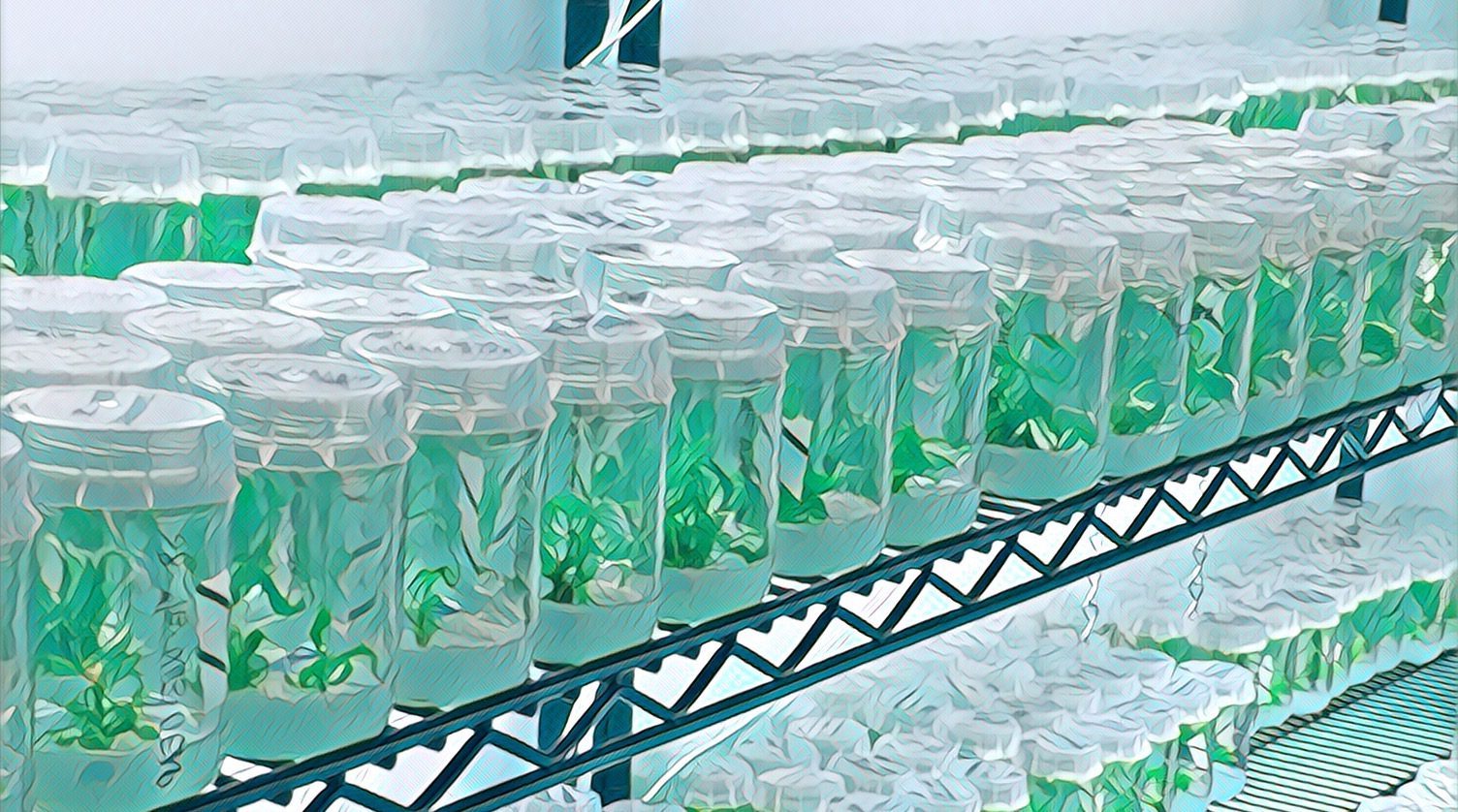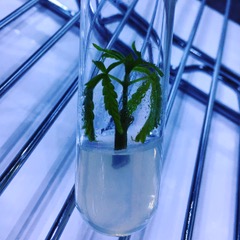
You may have noticed, Strainly allows you to offer genetics under the form of tissue cultures. While seeds and clones have been quite common starting material among growers, micro propagation is fairly new in the hemp world. What is “TC”? What type of benefits will it bring to propagation and cultivation? How tissue culture will impact the industry?… We’ll try to answer these questions, among others in this article…
With its gradual legalization, hemp production scaled and modernized quickly over the past 10 years. As part of this transition to industrial horticulture, new challenges appeared, along with some innovative attempts to address them. One of them is Plant Tissue Culture, a technique already used in traditional horticulture, but still pretty new in the hemp world.
WHAT IS “TC”?
Tissue culture was initially used at scale in the orchid industry during the 1950’s. Today, Tissue Culture is also used for bananas, sugarcane, rice, corn, cotton… Tissue culture is also used to preserve endangered species.
Tissue Culture is commonly defined as “the controlled aseptic culturing of whole plants, plant cells, tissues, organs and protoplasts”. “Aseptic” means free from contaminates such as insects, germs or pathogens. The process for introducing plant cells into in vitro culture is rather simple, in theory.
The explant, a small section of the plant, is cleaned and placed into a sterilized receptacle containing a media substrate of agar, sugars and chemicals slowing the growth of the plant. When it comes to hemp, we take a micro node from the original plant and place it in a sterile test tube.

About two weeks later, the node has grown into a rootless plantlet. Under the right conditions, the plantlet can be divided endlessly into other micro-clones.
At this point, there are 2 possibilities:
- These micro-clones can be transferred into a “vault” for conservation or experiments.
- Or, they can be propagated into rooting media for cultivation in indoor/greenhouse conditions. The process of tissue culturing is generally described in four distinct stages.
In-vitro plant cells culture is the starting point of various horticultural and biotechnological processes. It is commonly used for other plants than hemp, but this is changing. As cultivators need increasingly large quantities of clean and consistent starting materials with short lead times, hemp tissue culture has seen increased investments and developments in recent years.
Tissue culture for propagation
The propagation of nodes is usually used for mass production of plantlets through in vitro vegetative multiplication in aseptic environment . When it takes weeks to grow a mature enough mother plant that will provide a few clones, tissue culture allows to start from smaller fragments of plants and to multiply them every few days. When done properly, the inventory of starter plants can quickly become abundant.

Tissue culture is an interesting alternative propagation approach for several reasons. It allows to propagate plants that are:
- Identical to each other and to mother plant (like when cloning)
- Pest and disease free
- More vigorous
Tissue culture for PRESERVATION
While patent-focused breeders/producers will see tissue culture as a way to store their Intellectual Property for as long as possible, true preservationists should not overlook this option. We have too many examples of great strains that went extinct and that we wish we had been able to keep a backup somewhere. As tissue culture democratizes, small-farm cultivators and individual growers should be able to keep such backups, for a lot longer. At least, there’s already a platform to offer and source them 🙂
At low temperatures, tissue culture allows to keep small plants intact for very long periods. Many plants have shown an ability to be stored in tissue culture at low temperature for long periods of time without cell damage. When returned to warmer temperatures, they can be propagated and re-integrated into the growing environment.
BEYOND BREEDING
Tissue culture is used in crop improvement programs within the “conventional” horticulture. Will it become a new way of creating new strains? A more effective one? What will be the impact on the phenotypes? Because of its cleaner nature, can tissue culture allow a reduction in the use of pest and pathogens management solutions?
IS TISSUE CULTURE A GATEWAY TO GMO HEMP?
According to Michael Stevens from Meristematic Labs, “even with the hemp industry still in its infancy, there are already companies planning on developing transgenic hemp products. Tissue culture techniques, in combination with highly specialized molecular techniques, have been successfully used to incorporate specific desired traits through gene transfer”… though Mike says we won’t see GMO products on the market before many years or even decades.
THE FUTURE OF HEMP TISSUE CULTURE
The question is not whether tissue culture will happen, not even when it will… it’s whether it will be easily accessible or not. An increasing number of tissue culture labs open, which is encouraging. The more “TC labs”, the more genetics will be available. If tissue culture remains in the hands of large-scale producers, there is likely a risk to see an increasing number of genotypes in a decreasing number of hands… Another crucial question is whether tissue culture will be primarily used in patent-driven breeding projects and bioengineering programs (i.e. to develop GMO hemp), or to support preservation efforts.
When it comes to propagation, time will tell whether affordable tissue culture technology can lower propagation costs for smaller scale producers, helping them to remain competitive and different, in an ever crowded market. That, combined with improved cultivation techniques and equipments represent potential efficiency gains opportunities for all canopy sizes.
With legalization, a growing number of home-growers with less experience may increasingly seek cleaner starter plants and turn to tissue culture providers. Tissue culture may simply be a requirement to meet the large demand for hemp propagation material ahead of us.
If you’d like to read more on hemp tissue culture, check out our article in Terpenes and Testing Magazine.

I am fascinated by this technique, I have to learn this way it seems like I could use less lights than usual and save time in grow cycle by not taking my nice tops for clones and having to wait for my plants to regrow again.
We are too Scott!
Outstanding article! You need a part two on your preferred media at each stage.
Thanks for the kind words Ethan!
TC is going to solve some big problems. Let’s not forget that we can remove any virus loads in our mother stock. And we have the opportunity to change the ploidy level in our plants! This means more copies of the DNA segments that make the things we want!
We need a second article on what TC can do for the professional plant breeder.
From the voices in my head
Ethan
I’m real interested in breeding and IMO, one of the big things about using TC in breeding is no more lost genetics. You get that killer plant, run some cultures and, like the man said, low temps will keep them from growing.
Ethan, you have me intrigued. How did you learn and how can I learn more?
Thanks for your input Ethan!
Thankyou
Any questions, please do not hesitate to ask!
I’m really stoked about this site, I’ve never seen a site that only sold breeding stock. I’ve never seen pollen for sale much less tissue cultures. I’d never heard much about TC then I saw a nursery online, (Dark Heart) that uses TC for their clones.
That was it for me, I built a flow hood, bought some test tubes, and a Hemp Multiplication kit from Phytotech Labs and started cooking up media and cutting explants. I was fortunate to stumble across some excellent research articles on tissue culture from Uncle Sam’s very own supplier, the University of Mississippi and they’ve been real helpful. I have a 2x2x4 tent and I have cultures going right now.
I can get plantlets going pretty good but I haven’t gotten any of them to root yet. Also, I don’t know if you’ve ever heard of Plant Preservative Mixture or, PPM but if you haven’t, and you don’t have a lab, try it. It’s a heat tolerant biocide and since I started using it, the only contamination I’ve seen is on explants that were improperly sterilized. I don’t have any connection to the company that makes it, it’s just kick-ass.
You know, it’d be great to get a group of amateur tissue culturists going just to help each other out, I don’t mind sharing stuff.
Sounds like almost foolproof way to preserve genetics for later use. Where can more info be found about questions such as this? What is best way to store as far as environmental conditions? Thanks
Like to learn more and find as TC lab in w
Western Canada to work with
This is a process i am finally moving forward with in researching long term storage. These points are the reason we need to perfect these methods!